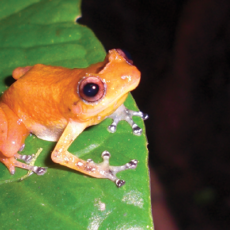- January 16, 2019
- By Chris Carroll
Following the paths that biology Professor Karen Lips established decades ago to survey frogs along the streams and through the lush cloud forest in the highlands of central Panama is a comparatively lifeless journey these days.
“On a good night, you’ll find maybe 20 frogs on a 200-meter transect, which is really sad,” says Grace DiRenzo Ph.D. ’16, a former student of Lips who has studied the worldwide amphibian die-off caused by chytridiomycosis, a fungal skin disease. “There’s so much empty space; I can’t imagine what Karen saw before the crash.”
Before the apocalyptic affliction hit El Copé National Park in late 2004, wiping out 42 of 74 local frog species and drastically depleting the rest, Lips had to watch out to avoid treading on the colorful hoppers, and surveying one transect and all its chirping frogs took five hours. In the following years, “the streams were dead silent,” and she could cover three of the routes in one hour.
So when they returned to Lips’ field study site at El Copé to survey the amphibians from 2010 to 2014, they thought they might find remnant populations drifting toward extinction. But what they found didn’t line up with expectations.
In a paper published in October in the journal Ecological Applications, lead author DiRenzo and senior author Lips show that frogs are now able to get on with their lives in the presence of the deadly chytrid fungus—with the majority population of infected frogs surviving at the same rate as the smaller percentage of uninfected ones.
It’s a hopeful development, though not exactly a feel-good story, Lips says. El Copé, she points out, hosts a lot of sick frogs.
“Maybe they’re not as active; maybe they don’t call as much,” she says. “They’re not super-sick, but even when you just have a cold, you can’t do as much. So they don’t get as big, they probably can’t be as successful, but they can survive.”
In addition to evolutionary changes within species that helped frogs survive, their far lower density in the environment following the die-off may also lessen the threat of the disease, DiRenzo says. The disappearance at El Copé of a so-called “super-shedder” species, the Panamanian golden frog—effectively a “Typhoid Mary” of chytridiomycosis, she says—may also have reduced its effect.
And now the frogs may be slowly coming back.
“This gives us a glimpse of hope that amphibian populations can persist in the face of major threats,” DiRenzo says. “It doesn’t mean they’ll ever fully rebound.”
Tags
Research